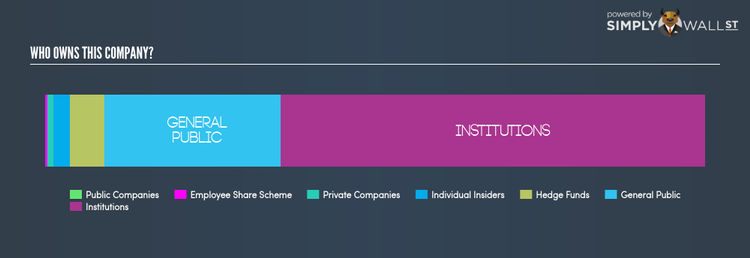Who Are The Top Investors In Victoria Oil & Gas Plc (LON:VOG)?

I am going to take a deep dive into Victoria Oil & Gas Plc’s (AIM:VOG) most recent ownership structure, not a frequent subject of discussion among individual investors. The impact of a company’s ownership structure affects both its short- and long-term performance. Differences in ownership structure of companies can have a profound effect on how management’s incentives are aligned with shareholder returns, which is why we’ll take a moment to analyse VOG’s shareholder registry. All data provided is as of the most recent financial year end.
View our latest analysis for Victoria Oil & Gas
Institutional Ownership
In VOG’s case, institutional ownership stands at 64.21%, significant enough to cause considerable price moves in the case of large institutional transactions, especially when there is a low level of public shares available on the market to trade. Although VOG has a high institutional ownership, such stock moves, in the short-term, are more commonly linked to a particular type of active institutional investors – hedge funds. Hedge funds, considered active investors, hold a 5.15% stake in the company, which may be the cause of high short-term volatility in the stock price. I am going to further examine VOG’s ownership structure to check how other major shareholders can affect its investment case.
Insider Ownership
Another important group of shareholders are company insiders. Insider ownership has to do more with how the company is managed and less to do with the direct impact of the magnitude of shares trading on the market. VOG insiders hold a not-so-significant 2.48% stake in the company, which somewhat aligns their interests with that of shareholders. However, a higher level of insider ownership has been linked to management executing on high-returning projects instead of expansion projects for the sake of apparent growth. It would also be interesting to check what insiders have been doing with their shareholding recently. Insider buying can be a positive indicator of future performance, but a selling decision can be simply driven by personal financial requirements.
General Public Ownership
A big stake of 26.76% in VOG is held by the general public. With this size of ownership, retail investors can collectively play a role in major company policies that affect shareholders returns, including executive remuneration and the appointment of directors. They can also exercise the power to decline an acquisition or merger that may not improve profitability.
Private Company Ownership
Potential investors in VOG should also look at another important group of investors: private companies, with a stake of 0.009%, who are primarily invested because of strategic and capital gain interests. However, an ownership of this size may be relatively insignificant, meaning that these shareholders may not have the potential to influence VOG’s business strategy. Thus, investors not need worry too much about the consequences of these holdings.
What this means for you:
I suggest investors seek some degree of margin of safety due to high institutional ownership in VOG, in particular due to the strong presence of active hedge fund investors. This is to avoid getting trapped in a sustained sell-off that is often observed in stocks with this level of institutional participation. However, if you are building an investment case for VOG, ownership structure alone should not dictate your decision to buy or sell the stock. Rather, you should be examining fundamental factors such as the intrinsic valuation, which is a key driver of Victoria Oil & Gas’s share price. I highly recommend you to complete your research by taking a look at the following:
1. Financial Health: Is VOG’s operations financially sustainable? Balance sheets can be hard to analyze, which is why we’ve done it for you. Check out our financial health checks here.
2. Past Track Record: Has VOG been consistently performing well irrespective of the ups and downs in the market? Go into more detail in the past performance analysis and take a look at the free visual representations of VOG’s historicals for more clarity.
3. Other High-Performing Stocks: Are there other stocks that provide better prospects with proven track records? Explore our free list of these great stocks here.
NB: Figures in this article are calculated using data from the last twelve months, which refer to the 12-month period ending on the last date of the month the financial statement is dated. This may not be consistent with full year annual report figures.
To help readers see pass the short term volatility of the financial market, we aim to bring you a long-term focused research analysis purely driven by fundamental data. Note that our analysis does not factor in the latest price sensitive company announcements.
The author is an independent contributor and at the time of publication had no position in the stocks mentioned.

